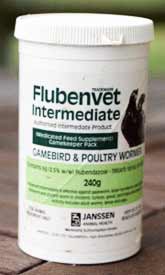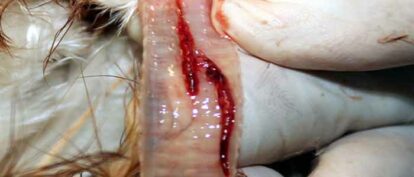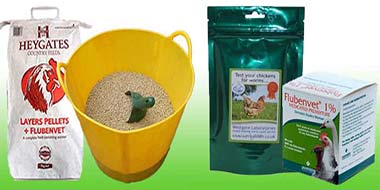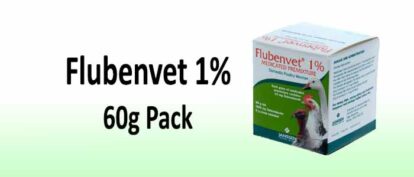Flubenvet 2.5% poultry wormer is a medicated feed supplement commonly used to worm chickens, turkeys and geese. It is not licensed for use with ducks although many people do use it. My article on worming chickens provides lots of information about worms and worming and there is separate information on Worming Ducks here.
 Flubenvet Intermediate (shown in the photo) is active against mature and immature nematodes (commonly known as worms) of the respiratory and gastrointestinal tract. There are 3 major worms that usually affect chickens – these are roundworms, gapeworms and tapeworms. Birds that are suffering from large worm infestations will look ruffled and their combs and wattles will go pale and they can look as if they have little or no flesh on the breast.
Flubenvet Intermediate (shown in the photo) is active against mature and immature nematodes (commonly known as worms) of the respiratory and gastrointestinal tract. There are 3 major worms that usually affect chickens – these are roundworms, gapeworms and tapeworms. Birds that are suffering from large worm infestations will look ruffled and their combs and wattles will go pale and they can look as if they have little or no flesh on the breast.
Another common sign of worms in chickens is a messy bottom. Flubenvet contains the active ingredient Flubendazole which has no adverse effect on egg-laying or hatching.
It is one of only a few licensed wormers for chickens currently available in the UK. It is very effective and can prevent a large number of problems and long-term damage to your birds.
You do not need to withdraw eggs for consumption when it is given at the correct dose and it is simple to administer in food.
Flubenvet for the hobby poultry keeper
The newer Flubenvet 1% Premixture is more suited to hobby poultry keepers. It comes with a handy scoop for measuring out the right quantity and a pack can treat approximately 20 chickens (large fowl).
There is separate information about Flubenvet 1% 60g tubs here. It is better to buy the 1% premixture unless you have a large number of birds to treat as you don’t need accurate weighing scales to measure out the required quantity of Flubenvet 2.5% intermediate.
Premixed Flubenvet with Layers Pellets is also available in some places – quite simply a bag of feed, ready mixed with Flubenvet.
Before using Flubenvet
Before you use Flubenvet, I would highly recommend you check to see whether it is actually necessary, by using a worm count kit (which is very easy to use).
You’ve probably heard about antibiotic resistance and the resistance that worms have built up in other farmed animals such as sheep? Well unfortunately it’s the same with chickens. If we over-use Flubendazole (the active ingredient in Flubenvet) then we risk having resistant worms in the future.
In a nutshell, a small number of worms might survive treatment and these go on to produce future generations of worms with the same genetic traits. Just like we’ve selected our chickens over the years to get our specific breeds, we are inadvertently selecting worms that are resistant to the wormer!
So before you use Flubenvet, please consider checking whether it is necessary with a worm-count kit.
Flubenvet key facts
The following information applies to the 240 g tub of 2.5% pre-mixture (shown above right) although much of it is the same for the 1% premixture: It’s the dosage that differs because it is a different strength formulation
Used to treat: Large roundworm, caecal worm, gapeworm, hairworm and gizzard worm in chickens, geese, turkeys, partridges and pheasants.
Dosage: Chickens and Geese: 12g per 10kg of feed. Pheasants and partridges: 24g per 10Kg of feed. Turkeys: 8g per 10Kg of feed.
Active ingredient: Flubendazole 2.5% (Various other pre-mixtures are also available with different quantities of Flubendazole such as Flubenvet 1% 60g packs).
Egg withdrawal for chickens: Nil at this rate.
Egg withdrawal for Goose, Turkey, Pheasant and Partridges Eggs: Must be withdrawn for the treatment period plus 7 days.
Slaughtering for meat for human consumption: 7 days after the last treatment
Length of treatment: 7 days.
Category: POM-VPS
Storage: In tightly closed original container below 25ºC and out of reach of children.
Common Flubenvet problems
A common problem people find with mixing it is getting Flubenvet to stick to pelleted feeds. You can mix the required quantity in a small amount of olive oil first before mixing the Flubenvet with the feed, it will then stick to the pellets. Make sure the pellets are well mixed afterwards.
Flubenvet can also be used to treat tapeworm if a vet prescribes it for your birds – usually they will advise 3 doses, 1 week apart ‘off label’ – which means that the vet needs to offer certain advice about the product not being specifically licensed for that purpose. Any vet wanting further advice can call Janssen and get all the information they need about this (contact details at the end of this article).
The advice given here is that of the authors and should not be considered as professional advice. Where there is conflicting information, you should always follow the advice of your vet or professional qualified person.
For further information about Flubenvet, you can contact the makers: Elanco (Formerly Janssen Animal Health), 50-100 Holmers Farm Way, High Wycombe, Bucks, HP12 4EG. Tel 01494 567555.




